:max_bytes(150000):strip_icc():format(webp)/streamfreesportsonline-5b1994178023b900364a81e5.jpg)
How to Add a Lower Third to Your Video

How to Add a Lower Third to Your Video
Want to bump up the quality and level of your videos? Adding a lower third is one of the easiest ways to impress your audience and improve the quality of your videos. It makes it look like you spent a ton of money on video editing, but in reality, it’s really easy to do.
When you first start video editing, it may seem like a daunting task with so much to learn. The good news is you can cut that learning curve down significantly by using intuitive editing software like Wondershare’s Filmora. Clear and streamlined, Filmora is the choice of many filmmakers.
Until recently, you needed expensive enterprise level software like Sony Vegas or Final Cut Pro to create lower thirds, especially lower thirds with movement. But Filmora makes it easier than ever.
- Use Readable Font
- Don’t Make It Too Long
- Use Branding
- Use Templates
- Keep It Simple
- Emphasize With Your Lower Third
- Step By Step To Explain Filmora
1. What is a Lower Third?

What is a Lower Third
A lower third is text and/or a graphical element put on top of your video for the purpose of sharing information with your audience.
A lower third provides important information but is done without distracting from the actual video content.
Take a look at the shot below. The lower third is used to convey the speaker’s name and profession. This is a type of lower third often used in documentary films and newscasts.
2. Why Add A Lower Third
So the next question a new filmmaker might ask is, “Why add a lower third?”
Funnily enough, despite its name, a lower third does not have to be in the lower third of the video but can be found in other areas of the screen.
In the shot below, the viewer automatically knows he is looking at the rooftops of Alfama, a neighborhood in Lisbon, without someone having to say it - no distractions from the video content.

Why Add A Lower Third
Lower thirds can also create movement. Many lower thirds come gliding onto the screen and add visual interest to a plain shot.
As simple as it may sound, seeing an overlay on a screen or a moving lower third adds professionalism to even the simplest videos. It gives the audience a sense of polish and high perceived value.
![]()
Tips: A lower third lasts approximately 3-6 seconds and is placed in the “title safe area” of your video. A quick explanation of the “title safe area” is that if the video is cropped to fit certain resolutions, your lower third will still appear without the fear of it being cropped out and losing pertinent information for the audience.
3. 6 Quick Tips to Add A Lower Third
As simple as putting in a lower third sounds, here are 6 quick tips to ensure a lower third is effective and conveys the right message.
Wondershare Filmora Video Editor comes equipped with pre-built video-based lower thirds in a ton of unique styles and colors. The cool thing is that you can customize the text easily and quickly, including changing the text color and font style – so you can match your style perfectly.
Tip #1
Use Readable Font
Part of communicating information without distraction is to make sure the font used in the lower third is readable. A lower third only graces the screen for 3-6 seconds, so you want it to be short and easy to read at a glance.
Tip #2
Don’t Make It Too Long
There is a limited amount of space to use. If you need to communicate more information, consider using a title slide instead which will give you more space to communicate your ideas. Less is more when it comes to lower thirds.
Tip #3
Use Branding
A lower third is another way to have people remember and recognize your brand. If you have your own branding colors and logo, use it in your lower third.
Tip #4
Use Templates
Pick one style and stick with it. Consistency in video editing helps communicate trust to your audience. It’s fun to use different styles sometimes, but it can be disjointed. With Filmora you can add elements like lower thirds and title to your favorites – so they are easy to use on your different video projects.
Tip #5
Keep It Simple
Remember the purpose of your lower third - to convey information without being distracting. Don’t use a lot of text. Brevity is the key. Usually, lower thirds are used to detail a name, profession or a location. The most you want is 2 lines of text. Sometimes you may want to use just one line.
Tip #6
Emphasize With Your Lower Third
Often, I might use a lower third to emphasize a certain point, or to use different wording (than I used in my video) if I think it makes the point clearer. This can be helpful if you make a small mistake in your original video and it makes more sense than adding b-roll over the video.
4. Step By Step To Explain Filmora
Using Wondershare Filmora Video Editor it is extremely easy to create a lower third for your video.
Free Download For Win 7 or later(64-bit)
Free Download For macOS 10.14 or later
The following step-by-step tutorial already assumes that you are familiar with some of the workings of Filmora like how to start a project and how to place your media onto the empty timeline.
So here’s how simple it is to add a lower third.
Step 1: Import The Media
In this step, you will create a new project and then import the media and place it on your timeline.
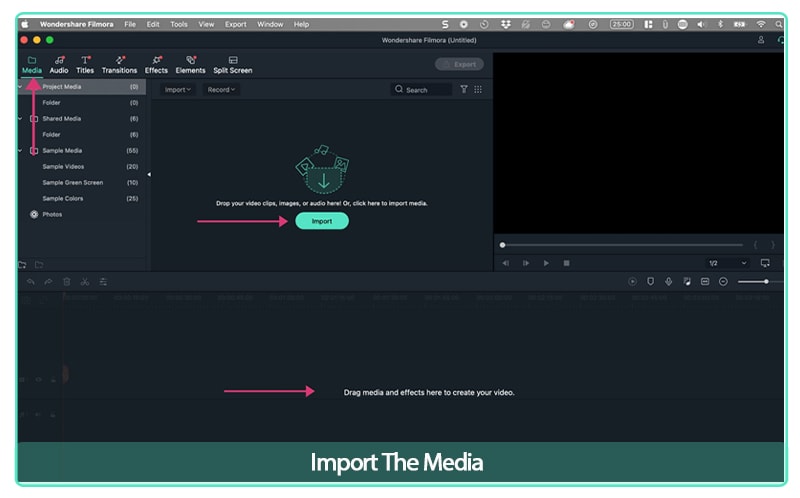
Import The Media
Step 2: Find Title Option
Once you have placed your media onto the project, you will go to the top navigation and click on titles.
It will then open up and you will see a number of choices for titles, including “lower thirds.”
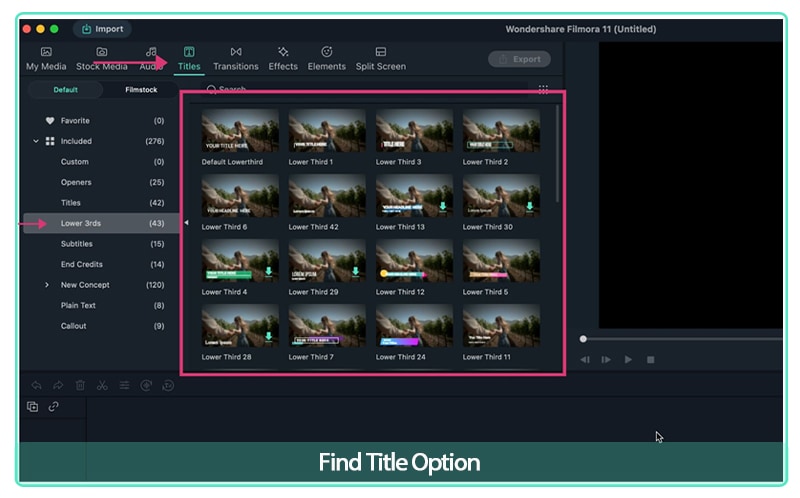
Find Title Option
For lower thirds you want to choose the template that will best compliment your video.
Things to consider are your branding colors and the information you want to convey.
Currently, there are many options to choose from with 43 lower third templates to choose from in Filmora.
Step 3: Choose a Lower Third Template
Choose a lower third template and drag it on top of your media in the timeline. The next step is to edit the template.
Double click on the template and it will allow you to edit the text.
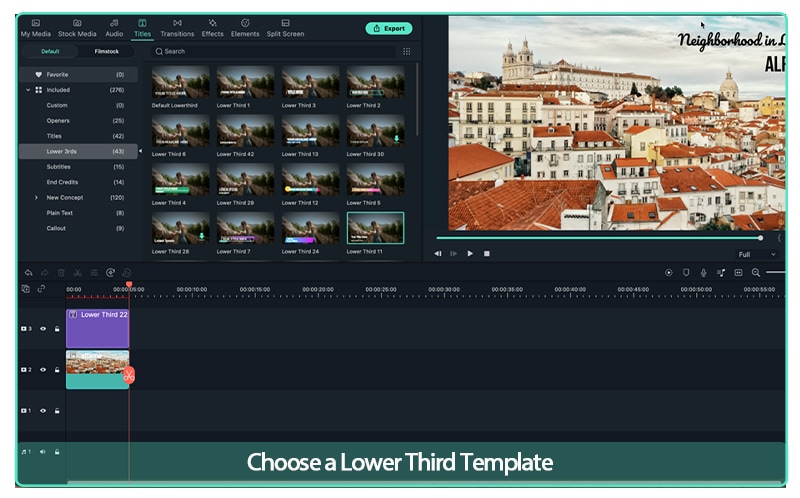
Choose a Lower Third Template
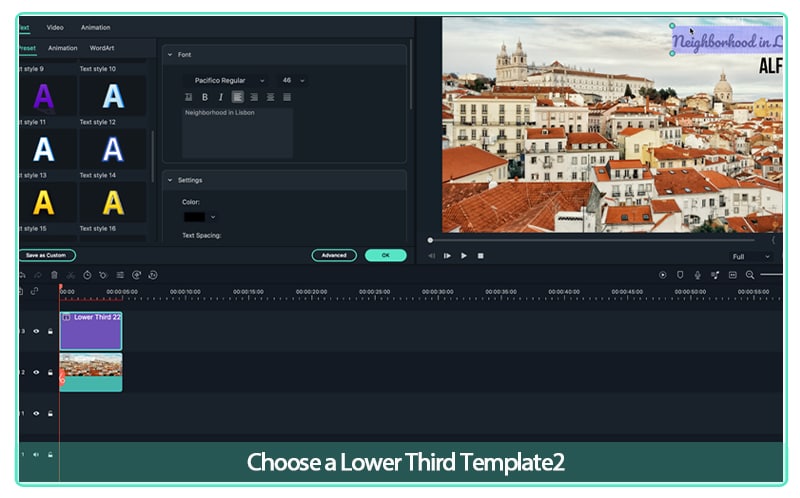
Choose a Lower Third Template2
Also, when deciding how often you need to use a lower third, you only need to use the lower third once - if the speaker appears on the screen again, it only needs to be shown that one time.
You did it. With this new skill you’ve now mastered the quickest way to impress your audience and increase the quality of your videos.
The key is to practice and you’ll get better quickly.
5. Start Using Lower Thirds Today
Lower thirds are a simple but powerful way to enhance your videos.
Using the tips above, start adding lower thirds to your video.
Wrap Up
Whether you are a new filmmaker/editor or a seasoned pro, Wondershare’s Filmora can help take your video editing to the next level. It’s packed with pro-level features that are easy and intuitive to use.
If you’re not using Filmora, download it today and discover how to make your videos look better as you build your audience.
Step By Step To Explain Filmora
1. What is a Lower Third?

What is a Lower Third
A lower third is text and/or a graphical element put on top of your video for the purpose of sharing information with your audience.
A lower third provides important information but is done without distracting from the actual video content.
Take a look at the shot below. The lower third is used to convey the speaker’s name and profession. This is a type of lower third often used in documentary films and newscasts.
2. Why Add A Lower Third
So the next question a new filmmaker might ask is, “Why add a lower third?”
Funnily enough, despite its name, a lower third does not have to be in the lower third of the video but can be found in other areas of the screen.
In the shot below, the viewer automatically knows he is looking at the rooftops of Alfama, a neighborhood in Lisbon, without someone having to say it - no distractions from the video content.

Why Add A Lower Third
Lower thirds can also create movement. Many lower thirds come gliding onto the screen and add visual interest to a plain shot.
As simple as it may sound, seeing an overlay on a screen or a moving lower third adds professionalism to even the simplest videos. It gives the audience a sense of polish and high perceived value.
![]()
Tips: A lower third lasts approximately 3-6 seconds and is placed in the “title safe area” of your video. A quick explanation of the “title safe area” is that if the video is cropped to fit certain resolutions, your lower third will still appear without the fear of it being cropped out and losing pertinent information for the audience.
3. 6 Quick Tips to Add A Lower Third
As simple as putting in a lower third sounds, here are 6 quick tips to ensure a lower third is effective and conveys the right message.
Wondershare Filmora Video Editor comes equipped with pre-built video-based lower thirds in a ton of unique styles and colors. The cool thing is that you can customize the text easily and quickly, including changing the text color and font style – so you can match your style perfectly.
Tip #1
Use Readable Font
Part of communicating information without distraction is to make sure the font used in the lower third is readable. A lower third only graces the screen for 3-6 seconds, so you want it to be short and easy to read at a glance.
Tip #2
Don’t Make It Too Long
There is a limited amount of space to use. If you need to communicate more information, consider using a title slide instead which will give you more space to communicate your ideas. Less is more when it comes to lower thirds.
Tip #3
Use Branding
A lower third is another way to have people remember and recognize your brand. If you have your own branding colors and logo, use it in your lower third.
Tip #4
Use Templates
Pick one style and stick with it. Consistency in video editing helps communicate trust to your audience. It’s fun to use different styles sometimes, but it can be disjointed. With Filmora you can add elements like lower thirds and title to your favorites – so they are easy to use on your different video projects.
Tip #5
Keep It Simple
Remember the purpose of your lower third - to convey information without being distracting. Don’t use a lot of text. Brevity is the key. Usually, lower thirds are used to detail a name, profession or a location. The most you want is 2 lines of text. Sometimes you may want to use just one line.
Tip #6
Emphasize With Your Lower Third
Often, I might use a lower third to emphasize a certain point, or to use different wording (than I used in my video) if I think it makes the point clearer. This can be helpful if you make a small mistake in your original video and it makes more sense than adding b-roll over the video.
4. Step By Step To Explain Filmora
Using Wondershare Filmora Video Editor it is extremely easy to create a lower third for your video.
Free Download For Win 7 or later(64-bit)
Free Download For macOS 10.14 or later
The following step-by-step tutorial already assumes that you are familiar with some of the workings of Filmora like how to start a project and how to place your media onto the empty timeline.
So here’s how simple it is to add a lower third.
Step 1: Import The Media
In this step, you will create a new project and then import the media and place it on your timeline.

Import The Media
Step 2: Find Title Option
Once you have placed your media onto the project, you will go to the top navigation and click on titles.
It will then open up and you will see a number of choices for titles, including “lower thirds.”

Find Title Option
For lower thirds you want to choose the template that will best compliment your video.
Things to consider are your branding colors and the information you want to convey.
Currently, there are many options to choose from with 43 lower third templates to choose from in Filmora.
Step 3: Choose a Lower Third Template
Choose a lower third template and drag it on top of your media in the timeline. The next step is to edit the template.
Double click on the template and it will allow you to edit the text.

Choose a Lower Third Template

Choose a Lower Third Template2
Also, when deciding how often you need to use a lower third, you only need to use the lower third once - if the speaker appears on the screen again, it only needs to be shown that one time.
You did it. With this new skill you’ve now mastered the quickest way to impress your audience and increase the quality of your videos.
The key is to practice and you’ll get better quickly.
5. Start Using Lower Thirds Today
Lower thirds are a simple but powerful way to enhance your videos.
Using the tips above, start adding lower thirds to your video.
Wrap Up
- Whether you are a new filmmaker/editor or a seasoned pro, Wondershare’s Filmora can help take your video editing to the next level. It’s packed with pro-level features that are easy and intuitive to use.
- If you’re not using Filmora, download it today and discover how to make your videos look better as you build your audience.
How To Trim Video In Premiere Pro in Different Ways
Create High-Quality Video - Wondershare Filmora
An easy and powerful YouTube video editor
Numerous video and audio effects to choose from
Detailed tutorials provided by the official channel
Trimming your video is one of the most effective ways to get the viewer’s attention. As such, you should always trim the end and beginning of your videos to a length that will not repel viewers. Premiere Pro can help you trim videos, leaving you with tight and compelling content that engages your audience. Developed by Adobe Inc., this timeline-based video editing software application is ideal for those who want to produce the best video. We’ll explain how to trim videos in Premiere Pro.
In this article
01 What Is the Difference Between Cutting and Trimming a Video?
02 How to Trim videos in Premiere Pro in Different Ways
03 Extra Tips About Trimming Videos in Premiere Pro
What Is the Difference Between Cutting and Trimming a Video?
If you are new to video editing, you might find that cutting and trimming video files sound the same to you. At first sight, you’ll see that these two operations are similar because they involve the cutting of videos. Let’s look at the differences between these two operations.
Trimming
Trimming is the process of cutting off a portion of the end or beginning of your video to reduce its length, leaving the desired content only. Trimming is vital when you want to ensure your video starts swiftly and your viewers will not get bored while waiting for something captivating to occur.
The first seconds of a video are what draw viewers’ attention and convince them to continue watching the entire video. When you apply it intelligently, video trimming allows you to remove unnecessary frames from the beginning and end of your video and leave content that your audience will like.
Cutting
Cutting is also a fundamental video editing skill, and it involves removing a portion of a video clip by cutting in two places. You’ll then lift out the middle area and combine the leftover video back together.
This operation is helpful when you want to polish your video and cut off meaningless snippets. What’s more? You can apply cutting if you intend to insert a section of your video clip into another one.
You might want to consider cutting when you want to share your video on social networks and need to cut it into pieces due to the video length limits.
People often confuse trimming with cutting because they are all about deleting sections of the video. However, trimming involves deleting the beginning and end of a video, while cutting refers to cutting a part of a video file from somewhere else. Understanding this crucial difference will allow you to edit your videos like a professional.
How to Trim videos in Premiere Pro in Different Ways
You can trim video Premiere Pro on the timeline or program. Let’s look at these two methods.
Method 1:Trim Clips on Timeline
If you are wondering: What is a timeline? It’s the area Premiere Pro where you arrange your videos and map out the edits you want to apply. You will see all your video clips, transitions, effects, and more laid out in chronological order while you are working on your project. You can Premiere Pro trim video clips on the timeline, and at any point, play your project to check how your edits will look.
Remember that edits on the Premiere Pro timeline don’t alter your source files, and they are previews of how your edits will appear. That means you can untrim a video clip to extend it to its original length without consequence.
To learn how to trim video in Premiere Pro on the timeline, follow the steps below.
- Double click on the video file you want to trim in Premiere Pro.
- Adjust the timings of your edits. Drag the ends of your video clip as if you are resizing a window to shorten or extend by trimming. As your cursor gets closer at the edge of the video clip, you’ll see a red arrow.
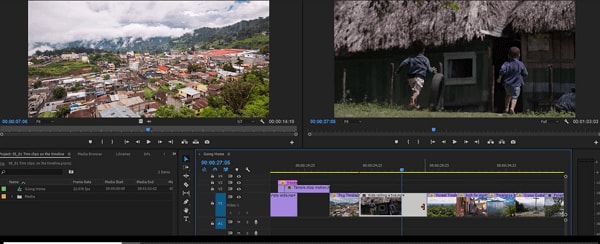
- The Ripple Edit tool lets you trim video clips without leaving a white gap. You can also use it to push adjacent video clips later in the sequence.

- The Rolling Edit tool allows you to adjust the timing of the edit you make between two video clips and extends a clip by the same size you shorten the other.
- Click the padlock icon located on the tracker header to lock the entire track and prevent unwanted changes.
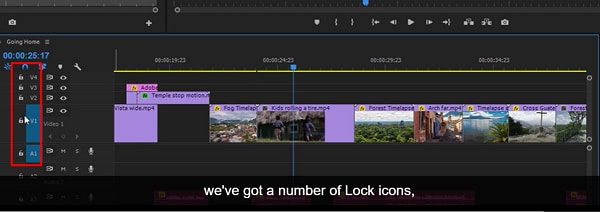
- You can also use the Q and W keys on your keyboard to Premiere Pro trim video. The Q key removes unwanted content at the beginning of the clip, while the W key trims the end of the clip.
- Choose the Selection tool once you’ve finished using the trimming tools.
Method 2:Trim Clips in the Program
You can also trim videos in the Program Monitor. Follow the guide below to learn how to trim a video in Premiere Pro program monitor.
- Double-click the end of your video clip to enter the Trim Mode in the program.
- To trim, drag on the images of your video in the program monitor. You can also use the buttons on the panel.
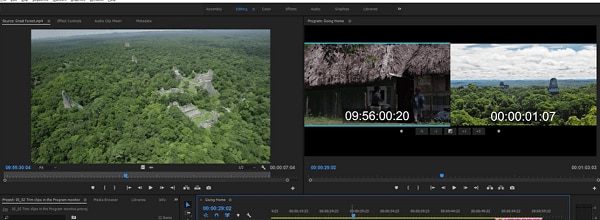
- To exit Trim mode, click an empty section in the Timeline panel.
You can change how trimming works by Command-clicking (macOS) or Control-clicking (Windows) on the images of the video in the program while you are in the Timeline panel or Trim Mode. The yellow cursor means ripple trimming, while the red pointer means regular trimming.
The benefit of trimming videos in the Program Monitor is that the precision adjustment buttons under the footage allow you to trim 1 or 5 frames at a time.
Extra Tips About Trimming Videos in Premiere Pro
We have provided some tips that you should keep in mind when using Adobe Premiere trim video.
How to Trim a Video without Re-Rendering?
When adding a video to Premiere Pro, it will be rendered by this software application to ensure high-quality playback and speed. Rendering takes time afterward, leading to loss of quality; however, it makes sure you have gotten the best video quality as much as possible by removing skipped frames and lag from the video playback.
If you are wondering how to trim videos in Premiere Pro without re-render follow the steps below:
- Import your video to Premiere Pro by launching the application and choosing ‘Import Media to Start’. Browse and select the video you want to trim.
- The video will appear in the media library area at the bottom of the screen.
- Drag and drop the video from the media library to the timeline. You’ll see the complete video clip duration in the timeline.
- You can crop the video by dragging the blue time marker to the duration where you would like to start the video.
- Hold the ‘Ctrl’ key on your keyboard, then drag the starting end of the video clip to the time marker position. You’ll remove unnecessary video content from the beginning of your video.
- You can trim the video from its other end by following the same steps but from the opposite direction. You can only use this method to trim from one of the ends of your video clip.
- Choose the ‘Laser Tool’ located at the side menu of the timeline to trim from the center of the video clip. Now, click on the clip at the position you want to trim, and the application will cut the video from this position.
- Follow steps 2 to 4 to trim from cuts you’ve just made.
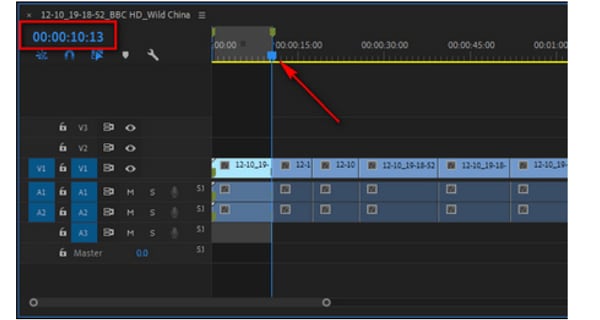
- Go to ‘File’ and choose the ‘Export’ option. Tap ‘Media’ from the list, and you will be directed to the export setting. Here, you can adjust specific settings, such as quality, name, and format. Click ‘Export’ after entering the appropriate information.
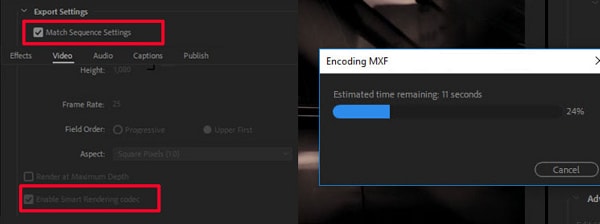
Unlink Audio and Video for Trimming
When you upload a video file to Adobe Premiere Pro and take it into the timeline, the audio tracks and video will be synced and locked. Essentially, this ensures there is no misalignment when the program converts the video to another format. For example, importing it into another video editor can cause a mis-sync between audio and video if the two tracks are not locked or linked.
Video editing professionals avoid this by locking the two tracks together. As such, you might want to unlink or unlock the two before doing anything. To do this, you need to import the video into the application and take it to the timeline with the associated tracks. Then, select the video track alone.
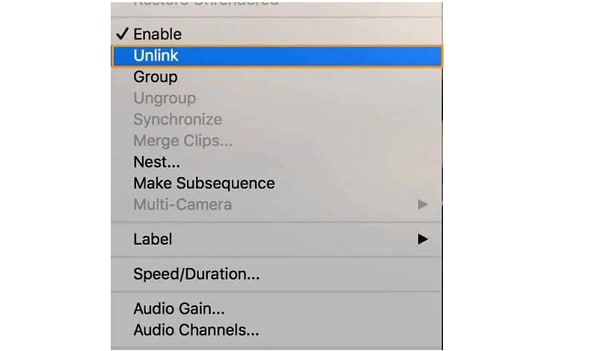
Next, right-click the video track and select the Unlink option. The software will separate the audio from the video track. You can now trim either of these.
How to Trim and Re-Encode Videos without Re-Rendering
Follow the method below to trim video Premiere Pro and encode it without rendering it.
- Launch Premiere Pro and navigate to File, then choose import. Find the video that you want to trim and double click on it.
- Drag and drop the video into the timeline.
- Choose the ‘Ripple Edit Tool’ and then Press ‘Sequence’. Head to ‘Sequence Settings’ and set or modify the codec, bitrate, name, format, and much more.
- Adjust the Ripple so that it defines the end time and start time that you want for your video.
- Now, finalize the trim by choosing ‘File’ and tap ‘Export’. To ‘Export Settings,’ elect ‘Media’.
Conclusion
● Now that you know how to trim videos in Premiere Pro, you can remove unnecessary portions at the beginning or end of your videos. In turn, your videos will attract more viewers.
Trimming your video is one of the most effective ways to get the viewer’s attention. As such, you should always trim the end and beginning of your videos to a length that will not repel viewers. Premiere Pro can help you trim videos, leaving you with tight and compelling content that engages your audience. Developed by Adobe Inc., this timeline-based video editing software application is ideal for those who want to produce the best video. We’ll explain how to trim videos in Premiere Pro.
In this article
01 What Is the Difference Between Cutting and Trimming a Video?
02 How to Trim videos in Premiere Pro in Different Ways
03 Extra Tips About Trimming Videos in Premiere Pro
What Is the Difference Between Cutting and Trimming a Video?
If you are new to video editing, you might find that cutting and trimming video files sound the same to you. At first sight, you’ll see that these two operations are similar because they involve the cutting of videos. Let’s look at the differences between these two operations.
Trimming
Trimming is the process of cutting off a portion of the end or beginning of your video to reduce its length, leaving the desired content only. Trimming is vital when you want to ensure your video starts swiftly and your viewers will not get bored while waiting for something captivating to occur.
The first seconds of a video are what draw viewers’ attention and convince them to continue watching the entire video. When you apply it intelligently, video trimming allows you to remove unnecessary frames from the beginning and end of your video and leave content that your audience will like.
Cutting
Cutting is also a fundamental video editing skill, and it involves removing a portion of a video clip by cutting in two places. You’ll then lift out the middle area and combine the leftover video back together.
This operation is helpful when you want to polish your video and cut off meaningless snippets. What’s more? You can apply cutting if you intend to insert a section of your video clip into another one.
You might want to consider cutting when you want to share your video on social networks and need to cut it into pieces due to the video length limits.
People often confuse trimming with cutting because they are all about deleting sections of the video. However, trimming involves deleting the beginning and end of a video, while cutting refers to cutting a part of a video file from somewhere else. Understanding this crucial difference will allow you to edit your videos like a professional.
How to Trim videos in Premiere Pro in Different Ways
You can trim video Premiere Pro on the timeline or program. Let’s look at these two methods.
Method 1:Trim Clips on Timeline
If you are wondering: What is a timeline? It’s the area Premiere Pro where you arrange your videos and map out the edits you want to apply. You will see all your video clips, transitions, effects, and more laid out in chronological order while you are working on your project. You can Premiere Pro trim video clips on the timeline, and at any point, play your project to check how your edits will look.
Remember that edits on the Premiere Pro timeline don’t alter your source files, and they are previews of how your edits will appear. That means you can untrim a video clip to extend it to its original length without consequence.
To learn how to trim video in Premiere Pro on the timeline, follow the steps below.
- Double click on the video file you want to trim in Premiere Pro.
- Adjust the timings of your edits. Drag the ends of your video clip as if you are resizing a window to shorten or extend by trimming. As your cursor gets closer at the edge of the video clip, you’ll see a red arrow.

- The Ripple Edit tool lets you trim video clips without leaving a white gap. You can also use it to push adjacent video clips later in the sequence.

- The Rolling Edit tool allows you to adjust the timing of the edit you make between two video clips and extends a clip by the same size you shorten the other.
- Click the padlock icon located on the tracker header to lock the entire track and prevent unwanted changes.

- You can also use the Q and W keys on your keyboard to Premiere Pro trim video. The Q key removes unwanted content at the beginning of the clip, while the W key trims the end of the clip.
- Choose the Selection tool once you’ve finished using the trimming tools.
Method 2:Trim Clips in the Program
You can also trim videos in the Program Monitor. Follow the guide below to learn how to trim a video in Premiere Pro program monitor.
- Double-click the end of your video clip to enter the Trim Mode in the program.
- To trim, drag on the images of your video in the program monitor. You can also use the buttons on the panel.

- To exit Trim mode, click an empty section in the Timeline panel.
You can change how trimming works by Command-clicking (macOS) or Control-clicking (Windows) on the images of the video in the program while you are in the Timeline panel or Trim Mode. The yellow cursor means ripple trimming, while the red pointer means regular trimming.
The benefit of trimming videos in the Program Monitor is that the precision adjustment buttons under the footage allow you to trim 1 or 5 frames at a time.
Extra Tips About Trimming Videos in Premiere Pro
We have provided some tips that you should keep in mind when using Adobe Premiere trim video.
How to Trim a Video without Re-Rendering?
When adding a video to Premiere Pro, it will be rendered by this software application to ensure high-quality playback and speed. Rendering takes time afterward, leading to loss of quality; however, it makes sure you have gotten the best video quality as much as possible by removing skipped frames and lag from the video playback.
If you are wondering how to trim videos in Premiere Pro without re-render follow the steps below:
- Import your video to Premiere Pro by launching the application and choosing ‘Import Media to Start’. Browse and select the video you want to trim.
- The video will appear in the media library area at the bottom of the screen.
- Drag and drop the video from the media library to the timeline. You’ll see the complete video clip duration in the timeline.
- You can crop the video by dragging the blue time marker to the duration where you would like to start the video.
- Hold the ‘Ctrl’ key on your keyboard, then drag the starting end of the video clip to the time marker position. You’ll remove unnecessary video content from the beginning of your video.
- You can trim the video from its other end by following the same steps but from the opposite direction. You can only use this method to trim from one of the ends of your video clip.
- Choose the ‘Laser Tool’ located at the side menu of the timeline to trim from the center of the video clip. Now, click on the clip at the position you want to trim, and the application will cut the video from this position.
- Follow steps 2 to 4 to trim from cuts you’ve just made.

- Go to ‘File’ and choose the ‘Export’ option. Tap ‘Media’ from the list, and you will be directed to the export setting. Here, you can adjust specific settings, such as quality, name, and format. Click ‘Export’ after entering the appropriate information.

Unlink Audio and Video for Trimming
When you upload a video file to Adobe Premiere Pro and take it into the timeline, the audio tracks and video will be synced and locked. Essentially, this ensures there is no misalignment when the program converts the video to another format. For example, importing it into another video editor can cause a mis-sync between audio and video if the two tracks are not locked or linked.
Video editing professionals avoid this by locking the two tracks together. As such, you might want to unlink or unlock the two before doing anything. To do this, you need to import the video into the application and take it to the timeline with the associated tracks. Then, select the video track alone.

Next, right-click the video track and select the Unlink option. The software will separate the audio from the video track. You can now trim either of these.
How to Trim and Re-Encode Videos without Re-Rendering
Follow the method below to trim video Premiere Pro and encode it without rendering it.
- Launch Premiere Pro and navigate to File, then choose import. Find the video that you want to trim and double click on it.
- Drag and drop the video into the timeline.
- Choose the ‘Ripple Edit Tool’ and then Press ‘Sequence’. Head to ‘Sequence Settings’ and set or modify the codec, bitrate, name, format, and much more.
- Adjust the Ripple so that it defines the end time and start time that you want for your video.
- Now, finalize the trim by choosing ‘File’ and tap ‘Export’. To ‘Export Settings,’ elect ‘Media’.
Conclusion
● Now that you know how to trim videos in Premiere Pro, you can remove unnecessary portions at the beginning or end of your videos. In turn, your videos will attract more viewers.
Trimming your video is one of the most effective ways to get the viewer’s attention. As such, you should always trim the end and beginning of your videos to a length that will not repel viewers. Premiere Pro can help you trim videos, leaving you with tight and compelling content that engages your audience. Developed by Adobe Inc., this timeline-based video editing software application is ideal for those who want to produce the best video. We’ll explain how to trim videos in Premiere Pro.
In this article
01 What Is the Difference Between Cutting and Trimming a Video?
02 How to Trim videos in Premiere Pro in Different Ways
03 Extra Tips About Trimming Videos in Premiere Pro
What Is the Difference Between Cutting and Trimming a Video?
If you are new to video editing, you might find that cutting and trimming video files sound the same to you. At first sight, you’ll see that these two operations are similar because they involve the cutting of videos. Let’s look at the differences between these two operations.
Trimming
Trimming is the process of cutting off a portion of the end or beginning of your video to reduce its length, leaving the desired content only. Trimming is vital when you want to ensure your video starts swiftly and your viewers will not get bored while waiting for something captivating to occur.
The first seconds of a video are what draw viewers’ attention and convince them to continue watching the entire video. When you apply it intelligently, video trimming allows you to remove unnecessary frames from the beginning and end of your video and leave content that your audience will like.
Cutting
Cutting is also a fundamental video editing skill, and it involves removing a portion of a video clip by cutting in two places. You’ll then lift out the middle area and combine the leftover video back together.
This operation is helpful when you want to polish your video and cut off meaningless snippets. What’s more? You can apply cutting if you intend to insert a section of your video clip into another one.
You might want to consider cutting when you want to share your video on social networks and need to cut it into pieces due to the video length limits.
People often confuse trimming with cutting because they are all about deleting sections of the video. However, trimming involves deleting the beginning and end of a video, while cutting refers to cutting a part of a video file from somewhere else. Understanding this crucial difference will allow you to edit your videos like a professional.
How to Trim videos in Premiere Pro in Different Ways
You can trim video Premiere Pro on the timeline or program. Let’s look at these two methods.
Method 1:Trim Clips on Timeline
If you are wondering: What is a timeline? It’s the area Premiere Pro where you arrange your videos and map out the edits you want to apply. You will see all your video clips, transitions, effects, and more laid out in chronological order while you are working on your project. You can Premiere Pro trim video clips on the timeline, and at any point, play your project to check how your edits will look.
Remember that edits on the Premiere Pro timeline don’t alter your source files, and they are previews of how your edits will appear. That means you can untrim a video clip to extend it to its original length without consequence.
To learn how to trim video in Premiere Pro on the timeline, follow the steps below.
- Double click on the video file you want to trim in Premiere Pro.
- Adjust the timings of your edits. Drag the ends of your video clip as if you are resizing a window to shorten or extend by trimming. As your cursor gets closer at the edge of the video clip, you’ll see a red arrow.

- The Ripple Edit tool lets you trim video clips without leaving a white gap. You can also use it to push adjacent video clips later in the sequence.

- The Rolling Edit tool allows you to adjust the timing of the edit you make between two video clips and extends a clip by the same size you shorten the other.
- Click the padlock icon located on the tracker header to lock the entire track and prevent unwanted changes.

- You can also use the Q and W keys on your keyboard to Premiere Pro trim video. The Q key removes unwanted content at the beginning of the clip, while the W key trims the end of the clip.
- Choose the Selection tool once you’ve finished using the trimming tools.
Method 2:Trim Clips in the Program
You can also trim videos in the Program Monitor. Follow the guide below to learn how to trim a video in Premiere Pro program monitor.
- Double-click the end of your video clip to enter the Trim Mode in the program.
- To trim, drag on the images of your video in the program monitor. You can also use the buttons on the panel.

- To exit Trim mode, click an empty section in the Timeline panel.
You can change how trimming works by Command-clicking (macOS) or Control-clicking (Windows) on the images of the video in the program while you are in the Timeline panel or Trim Mode. The yellow cursor means ripple trimming, while the red pointer means regular trimming.
The benefit of trimming videos in the Program Monitor is that the precision adjustment buttons under the footage allow you to trim 1 or 5 frames at a time.
Extra Tips About Trimming Videos in Premiere Pro
We have provided some tips that you should keep in mind when using Adobe Premiere trim video.
How to Trim a Video without Re-Rendering?
When adding a video to Premiere Pro, it will be rendered by this software application to ensure high-quality playback and speed. Rendering takes time afterward, leading to loss of quality; however, it makes sure you have gotten the best video quality as much as possible by removing skipped frames and lag from the video playback.
If you are wondering how to trim videos in Premiere Pro without re-render follow the steps below:
- Import your video to Premiere Pro by launching the application and choosing ‘Import Media to Start’. Browse and select the video you want to trim.
- The video will appear in the media library area at the bottom of the screen.
- Drag and drop the video from the media library to the timeline. You’ll see the complete video clip duration in the timeline.
- You can crop the video by dragging the blue time marker to the duration where you would like to start the video.
- Hold the ‘Ctrl’ key on your keyboard, then drag the starting end of the video clip to the time marker position. You’ll remove unnecessary video content from the beginning of your video.
- You can trim the video from its other end by following the same steps but from the opposite direction. You can only use this method to trim from one of the ends of your video clip.
- Choose the ‘Laser Tool’ located at the side menu of the timeline to trim from the center of the video clip. Now, click on the clip at the position you want to trim, and the application will cut the video from this position.
- Follow steps 2 to 4 to trim from cuts you’ve just made.

- Go to ‘File’ and choose the ‘Export’ option. Tap ‘Media’ from the list, and you will be directed to the export setting. Here, you can adjust specific settings, such as quality, name, and format. Click ‘Export’ after entering the appropriate information.

Unlink Audio and Video for Trimming
When you upload a video file to Adobe Premiere Pro and take it into the timeline, the audio tracks and video will be synced and locked. Essentially, this ensures there is no misalignment when the program converts the video to another format. For example, importing it into another video editor can cause a mis-sync between audio and video if the two tracks are not locked or linked.
Video editing professionals avoid this by locking the two tracks together. As such, you might want to unlink or unlock the two before doing anything. To do this, you need to import the video into the application and take it to the timeline with the associated tracks. Then, select the video track alone.

Next, right-click the video track and select the Unlink option. The software will separate the audio from the video track. You can now trim either of these.
How to Trim and Re-Encode Videos without Re-Rendering
Follow the method below to trim video Premiere Pro and encode it without rendering it.
- Launch Premiere Pro and navigate to File, then choose import. Find the video that you want to trim and double click on it.
- Drag and drop the video into the timeline.
- Choose the ‘Ripple Edit Tool’ and then Press ‘Sequence’. Head to ‘Sequence Settings’ and set or modify the codec, bitrate, name, format, and much more.
- Adjust the Ripple so that it defines the end time and start time that you want for your video.
- Now, finalize the trim by choosing ‘File’ and tap ‘Export’. To ‘Export Settings,’ elect ‘Media’.
Conclusion
● Now that you know how to trim videos in Premiere Pro, you can remove unnecessary portions at the beginning or end of your videos. In turn, your videos will attract more viewers.
Trimming your video is one of the most effective ways to get the viewer’s attention. As such, you should always trim the end and beginning of your videos to a length that will not repel viewers. Premiere Pro can help you trim videos, leaving you with tight and compelling content that engages your audience. Developed by Adobe Inc., this timeline-based video editing software application is ideal for those who want to produce the best video. We’ll explain how to trim videos in Premiere Pro.
In this article
01 What Is the Difference Between Cutting and Trimming a Video?
02 How to Trim videos in Premiere Pro in Different Ways
03 Extra Tips About Trimming Videos in Premiere Pro
What Is the Difference Between Cutting and Trimming a Video?
If you are new to video editing, you might find that cutting and trimming video files sound the same to you. At first sight, you’ll see that these two operations are similar because they involve the cutting of videos. Let’s look at the differences between these two operations.
Trimming
Trimming is the process of cutting off a portion of the end or beginning of your video to reduce its length, leaving the desired content only. Trimming is vital when you want to ensure your video starts swiftly and your viewers will not get bored while waiting for something captivating to occur.
The first seconds of a video are what draw viewers’ attention and convince them to continue watching the entire video. When you apply it intelligently, video trimming allows you to remove unnecessary frames from the beginning and end of your video and leave content that your audience will like.
Cutting
Cutting is also a fundamental video editing skill, and it involves removing a portion of a video clip by cutting in two places. You’ll then lift out the middle area and combine the leftover video back together.
This operation is helpful when you want to polish your video and cut off meaningless snippets. What’s more? You can apply cutting if you intend to insert a section of your video clip into another one.
You might want to consider cutting when you want to share your video on social networks and need to cut it into pieces due to the video length limits.
People often confuse trimming with cutting because they are all about deleting sections of the video. However, trimming involves deleting the beginning and end of a video, while cutting refers to cutting a part of a video file from somewhere else. Understanding this crucial difference will allow you to edit your videos like a professional.
How to Trim videos in Premiere Pro in Different Ways
You can trim video Premiere Pro on the timeline or program. Let’s look at these two methods.
Method 1:Trim Clips on Timeline
If you are wondering: What is a timeline? It’s the area Premiere Pro where you arrange your videos and map out the edits you want to apply. You will see all your video clips, transitions, effects, and more laid out in chronological order while you are working on your project. You can Premiere Pro trim video clips on the timeline, and at any point, play your project to check how your edits will look.
Remember that edits on the Premiere Pro timeline don’t alter your source files, and they are previews of how your edits will appear. That means you can untrim a video clip to extend it to its original length without consequence.
To learn how to trim video in Premiere Pro on the timeline, follow the steps below.
- Double click on the video file you want to trim in Premiere Pro.
- Adjust the timings of your edits. Drag the ends of your video clip as if you are resizing a window to shorten or extend by trimming. As your cursor gets closer at the edge of the video clip, you’ll see a red arrow.

- The Ripple Edit tool lets you trim video clips without leaving a white gap. You can also use it to push adjacent video clips later in the sequence.

- The Rolling Edit tool allows you to adjust the timing of the edit you make between two video clips and extends a clip by the same size you shorten the other.
- Click the padlock icon located on the tracker header to lock the entire track and prevent unwanted changes.

- You can also use the Q and W keys on your keyboard to Premiere Pro trim video. The Q key removes unwanted content at the beginning of the clip, while the W key trims the end of the clip.
- Choose the Selection tool once you’ve finished using the trimming tools.
Method 2:Trim Clips in the Program
You can also trim videos in the Program Monitor. Follow the guide below to learn how to trim a video in Premiere Pro program monitor.
- Double-click the end of your video clip to enter the Trim Mode in the program.
- To trim, drag on the images of your video in the program monitor. You can also use the buttons on the panel.

- To exit Trim mode, click an empty section in the Timeline panel.
You can change how trimming works by Command-clicking (macOS) or Control-clicking (Windows) on the images of the video in the program while you are in the Timeline panel or Trim Mode. The yellow cursor means ripple trimming, while the red pointer means regular trimming.
The benefit of trimming videos in the Program Monitor is that the precision adjustment buttons under the footage allow you to trim 1 or 5 frames at a time.
Extra Tips About Trimming Videos in Premiere Pro
We have provided some tips that you should keep in mind when using Adobe Premiere trim video.
How to Trim a Video without Re-Rendering?
When adding a video to Premiere Pro, it will be rendered by this software application to ensure high-quality playback and speed. Rendering takes time afterward, leading to loss of quality; however, it makes sure you have gotten the best video quality as much as possible by removing skipped frames and lag from the video playback.
If you are wondering how to trim videos in Premiere Pro without re-render follow the steps below:
- Import your video to Premiere Pro by launching the application and choosing ‘Import Media to Start’. Browse and select the video you want to trim.
- The video will appear in the media library area at the bottom of the screen.
- Drag and drop the video from the media library to the timeline. You’ll see the complete video clip duration in the timeline.
- You can crop the video by dragging the blue time marker to the duration where you would like to start the video.
- Hold the ‘Ctrl’ key on your keyboard, then drag the starting end of the video clip to the time marker position. You’ll remove unnecessary video content from the beginning of your video.
- You can trim the video from its other end by following the same steps but from the opposite direction. You can only use this method to trim from one of the ends of your video clip.
- Choose the ‘Laser Tool’ located at the side menu of the timeline to trim from the center of the video clip. Now, click on the clip at the position you want to trim, and the application will cut the video from this position.
- Follow steps 2 to 4 to trim from cuts you’ve just made.

- Go to ‘File’ and choose the ‘Export’ option. Tap ‘Media’ from the list, and you will be directed to the export setting. Here, you can adjust specific settings, such as quality, name, and format. Click ‘Export’ after entering the appropriate information.

Unlink Audio and Video for Trimming
When you upload a video file to Adobe Premiere Pro and take it into the timeline, the audio tracks and video will be synced and locked. Essentially, this ensures there is no misalignment when the program converts the video to another format. For example, importing it into another video editor can cause a mis-sync between audio and video if the two tracks are not locked or linked.
Video editing professionals avoid this by locking the two tracks together. As such, you might want to unlink or unlock the two before doing anything. To do this, you need to import the video into the application and take it to the timeline with the associated tracks. Then, select the video track alone.

Next, right-click the video track and select the Unlink option. The software will separate the audio from the video track. You can now trim either of these.
How to Trim and Re-Encode Videos without Re-Rendering
Follow the method below to trim video Premiere Pro and encode it without rendering it.
- Launch Premiere Pro and navigate to File, then choose import. Find the video that you want to trim and double click on it.
- Drag and drop the video into the timeline.
- Choose the ‘Ripple Edit Tool’ and then Press ‘Sequence’. Head to ‘Sequence Settings’ and set or modify the codec, bitrate, name, format, and much more.
- Adjust the Ripple so that it defines the end time and start time that you want for your video.
- Now, finalize the trim by choosing ‘File’ and tap ‘Export’. To ‘Export Settings,’ elect ‘Media’.
Conclusion
● Now that you know how to trim videos in Premiere Pro, you can remove unnecessary portions at the beginning or end of your videos. In turn, your videos will attract more viewers.
IMovie Review – Is It The Best Video Editor for Mac Users?
If you are a Mac user and you are getting started in video editing, it is better if you start with a free video editing software. There is no need to download any external free video editor when you are a Mac user. This is because Mac comes with a pre-installed free video editor called iMovie editor. iMovie is a video editing app from Apple where you will get all the standard and some advanced features.
iMovie is extremely popular among Mac users for video editing because it is completely free and easy to use. In fact, iMovie is also available for iPhone and iPad users. You can start your video editing on your iPhone and transfer the same work to Mac to continue editing on your Mac. But the most important question is if iMovie editor is the best video editor for Mac users. Read our iMovie review and find out a better alternative.
Part 1. Key Features of iMovie
Even iMovie is completely free to use, it competes with several premium video editors in terms of features. There are only a handful of free video editors available that lets you edit 4K videos, and iMovie is one of them. Similarly, there are only a few premium video editors available that support editing the same video project on different devices like iMovie. Here are all the key features of iMovie that you should know.
Templates and Themes – iMovie comes with different templates and themes for creating different types of videos including cinematic videos. There are classy and trending themes available to create trailers and short films. These themes and templates have limited customization options so that you can adjust as per your requirements.
Basic Editing – iMovie lets you combine video clips, split a large video file, trim video parts, crop and rotate video. Besides, you get to zoom videos as well as resize them as you need. You can add texts and titles as well as apply different transitions wherever you want to.
Advanced Editing – You can change speed and turn your video clips into slow-motion videos. You can correct the color as well as stabilize them. Besides, you can apply green screen effect and split screen effect. Moreover, you can reverse video as well as put overlays on videos. iMovie is also capable of recording video and audio if you want to record your screen or webcam video.
Audio Editing – iMovie lets you edit audio as well which is an essential requirement in video editing. You can increase and decrease volume, change speed and add beat markers to a video if required. Coming to audio effects, you can apply fade-in and fade-out effects. You can mute the audio in your recorded video and add a background music instead. Moreover, you can add voiceover and choose royalty-free audio clips.
Transitions and Effects – Even though there are limited visual effects, there are unique and eye-catchy. iMovie keeps on adding new and trending effects with every update so that the users have enough options to make their videos stand out. iMovie also provides different backgrounds that you can use on your video to enhance its quality. Apart from visual effects, there are several standard audio effects available.
User Interface – iMovie comes with a simple and intuitive user interface that lets everyone edit videos instantly without prior experience. This is exactly why some users never go for premium video editors. The user interface is clean, and all options are readily available. You can upload media files on Media Library, and they are automatically categorized from where you can access them instantly.
Part 2. How to Edit Videos with iMovie?
iMovie comes pre-installed on Mac, and hence, there is no need to download and install the application. Coming to how to use iMovie, there are three types of projects you can choose on iMovie. They are Media, Projects, and Theater. Media is where your footages reside, Projects represent the main workspace, and Theater is where your finished projects reside. Here are the steps regarding iMovie edit video.
Step 1: Open iMovie and click on Projects. You will see two options Movie and Trailer. Click on Movie to edit your videos.

Step 2: Click on My Movie under Project Media and go to My Media. Import your video clips and audio files under My Media.
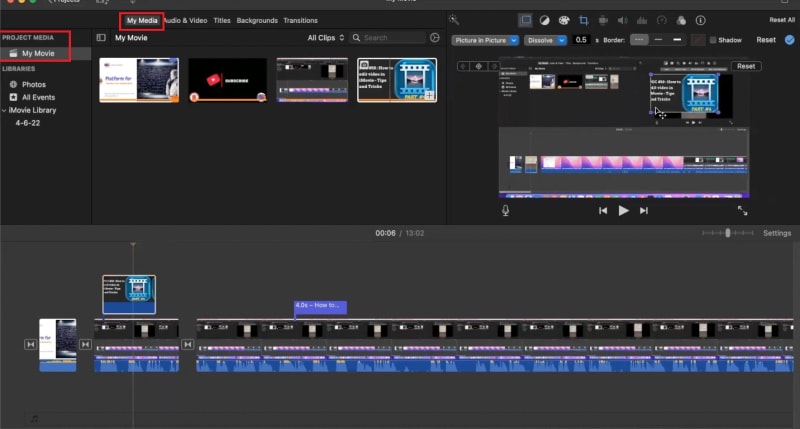
Step 3: Drag and drop the video clips and audio clips on the timeline in proper order. You can go for iMovie edit audio and video such as trimming as required.
Step 4: Go to Transitions located at the top bar beside My Media and place the desired transitions in between the video clips.
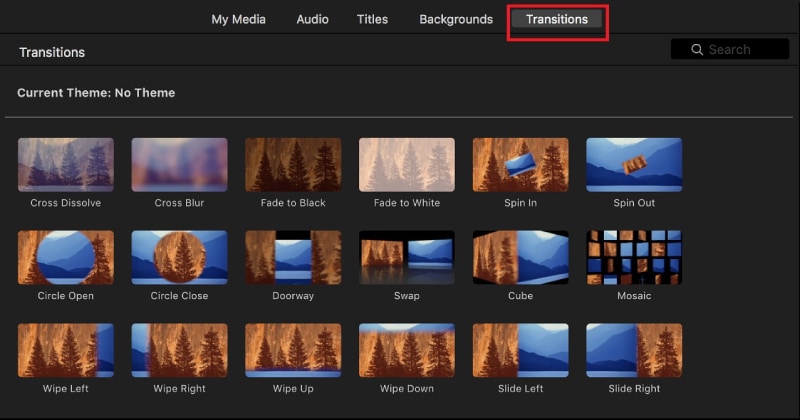
Step 5: Similarly, go to Titles located at the top bar beside Transitions and place them on the timeline wherever appropriate.
Step 6: Finally, check your edited video on the canvas and then go to the top-right corner and click on Export. You will have to option to save it in Theater and share on social media as well as through email and iTunes.

Part 3. Alternative to Edit Videos - Filmora
In spite of iMovie being a good video editor, Mac users search for a better alternative. This is because there are limited transitions and effects available. You can have two video tracks only on the timeline and there is lack of customization. Besides, the advanced features of video editing such as motion tracking are not available. Moreover, there are limited file formats supported for importing and exporting.
Wondershare Filmora is the best alternative to iMovie for Mac users. Filmora is a premium video editor where all the shortcomings of iMovie are taken care of. Filmora supports almost all file formats for media files. There is a wide range of transitions, effects, elements as well as animations available. Besides, there are different styles of texts and titles available along with stock media library. Here are the steps to edit videos with iMovie.
For Win 7 or later (64-bit)
For macOS 10.12 or later
Step 1: Download and install Filmora on your Mac. Launch Filmora and click on New Project.
Step 2: Drag and drop your video clips and audio files Project Media folder. Drag and place the video clips on the timeline and arrange per perfectly. Place audio files on the timeline on a different track.

Step 3: If you want to apply transitions, go to Transitions at the top bar and drag any transition in between video clips on the timeline. You can also insert texts from Titles and objects from Elements from the top bar.
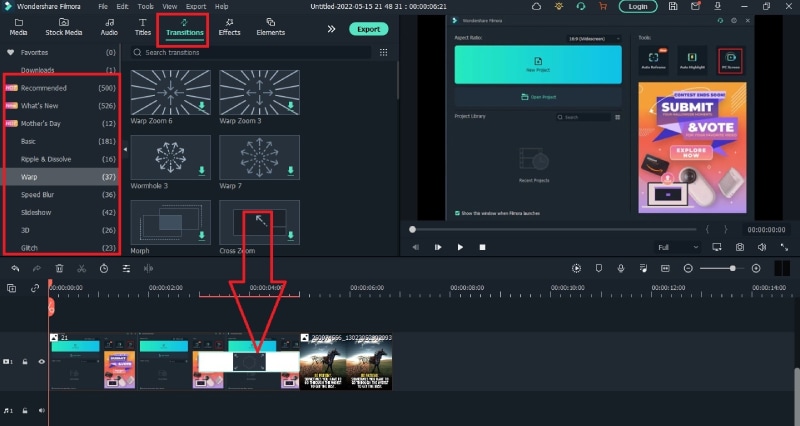
Step 4: Play the video to see the changes you have made, and click on Export button to save the video when you are satisfied.
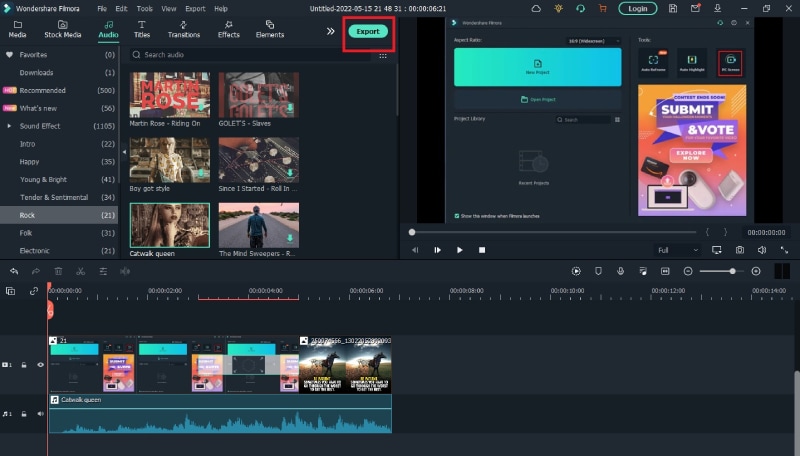
Part 4. FAQs about iMovie
Is iMovie good for video editing?
Yes, iMovie is good for basic video editing. You can edit 4K videos, and iMovie is available on macOS and iOS. If you are a beginner, iMovie is perfect for you. If you want advanced editing features, we recommend Wondershare Filmora.
What’s better Premiere Pro or iMovie?
In terms of features and functionalities, Premiere Pro is far better than iMovie. However, Premiere Pro is more for advanced video editing while iMovie is more for beginners. iMovie is simpler to use than Premiere Pro, and hence, beginners will love it.
Can I make YouTube videos with iMovie?
Yes, you can make YouTube videos with iMovie as it has all the required tools and options. Import your video clips and audio files on the timeline, go for iMovie edit clip like trim and crop as required, add transitions, texts, and effects as applicable and publish your finished video on YouTube.
For macOS 10.12 or later
Step 1: Download and install Filmora on your Mac. Launch Filmora and click on New Project.
Step 2: Drag and drop your video clips and audio files Project Media folder. Drag and place the video clips on the timeline and arrange per perfectly. Place audio files on the timeline on a different track.

Step 3: If you want to apply transitions, go to Transitions at the top bar and drag any transition in between video clips on the timeline. You can also insert texts from Titles and objects from Elements from the top bar.

Step 4: Play the video to see the changes you have made, and click on Export button to save the video when you are satisfied.

Part 4. FAQs about iMovie
Is iMovie good for video editing?
Yes, iMovie is good for basic video editing. You can edit 4K videos, and iMovie is available on macOS and iOS. If you are a beginner, iMovie is perfect for you. If you want advanced editing features, we recommend Wondershare Filmora.
What’s better Premiere Pro or iMovie?
In terms of features and functionalities, Premiere Pro is far better than iMovie. However, Premiere Pro is more for advanced video editing while iMovie is more for beginners. iMovie is simpler to use than Premiere Pro, and hence, beginners will love it.
Can I make YouTube videos with iMovie?
Yes, you can make YouTube videos with iMovie as it has all the required tools and options. Import your video clips and audio files on the timeline, go for iMovie edit clip like trim and crop as required, add transitions, texts, and effects as applicable and publish your finished video on YouTube.
For macOS 10.12 or later
Step 1: Download and install Filmora on your Mac. Launch Filmora and click on New Project.
Step 2: Drag and drop your video clips and audio files Project Media folder. Drag and place the video clips on the timeline and arrange per perfectly. Place audio files on the timeline on a different track.

Step 3: If you want to apply transitions, go to Transitions at the top bar and drag any transition in between video clips on the timeline. You can also insert texts from Titles and objects from Elements from the top bar.

Step 4: Play the video to see the changes you have made, and click on Export button to save the video when you are satisfied.

Part 4. FAQs about iMovie
Is iMovie good for video editing?
Yes, iMovie is good for basic video editing. You can edit 4K videos, and iMovie is available on macOS and iOS. If you are a beginner, iMovie is perfect for you. If you want advanced editing features, we recommend Wondershare Filmora.
What’s better Premiere Pro or iMovie?
In terms of features and functionalities, Premiere Pro is far better than iMovie. However, Premiere Pro is more for advanced video editing while iMovie is more for beginners. iMovie is simpler to use than Premiere Pro, and hence, beginners will love it.
Can I make YouTube videos with iMovie?
Yes, you can make YouTube videos with iMovie as it has all the required tools and options. Import your video clips and audio files on the timeline, go for iMovie edit clip like trim and crop as required, add transitions, texts, and effects as applicable and publish your finished video on YouTube.
For macOS 10.12 or later
Step 1: Download and install Filmora on your Mac. Launch Filmora and click on New Project.
Step 2: Drag and drop your video clips and audio files Project Media folder. Drag and place the video clips on the timeline and arrange per perfectly. Place audio files on the timeline on a different track.

Step 3: If you want to apply transitions, go to Transitions at the top bar and drag any transition in between video clips on the timeline. You can also insert texts from Titles and objects from Elements from the top bar.

Step 4: Play the video to see the changes you have made, and click on Export button to save the video when you are satisfied.

Part 4. FAQs about iMovie
Is iMovie good for video editing?
Yes, iMovie is good for basic video editing. You can edit 4K videos, and iMovie is available on macOS and iOS. If you are a beginner, iMovie is perfect for you. If you want advanced editing features, we recommend Wondershare Filmora.
What’s better Premiere Pro or iMovie?
In terms of features and functionalities, Premiere Pro is far better than iMovie. However, Premiere Pro is more for advanced video editing while iMovie is more for beginners. iMovie is simpler to use than Premiere Pro, and hence, beginners will love it.
Can I make YouTube videos with iMovie?
Yes, you can make YouTube videos with iMovie as it has all the required tools and options. Import your video clips and audio files on the timeline, go for iMovie edit clip like trim and crop as required, add transitions, texts, and effects as applicable and publish your finished video on YouTube.
Find The Best LUTs for Lightroom
Colors play an essential role in our lives. They add emotions, create moods, and set the tone for our experiences. Using colors in media is significant as they help create an atmosphere that improves your story. That’s why filmmakers and photographers focus so much on color grading and adjustment. For this purpose, they use different tools like LUTs.
You can use LUTs in your images and videos to achieve a particular look or feel in Lightroom. With LUTs, you can make fantastic color grading in Lightroom. Many paid and free LUTs for Lightroom are available to download and use for your media. Moreover, LUTs can save time and give your story perspective and emotion.
Part 1: How Are LUTs Influencing Video Editors?
There are many ways in which LUTs can help and influence content creators and video editors. From Lightroom presets to Premiere Pro presets, you can download any. However, you need to learn the many ways in which LUTs are helping editors.
Efficiency
LUTs (Lookup Tables) are a powerful tool that can help you in many ways if you are a video editor. First, they can make your editing process more efficient. You can apply color grading and correction to your footage, saving you time and increasing productivity. Instead of manually adjusting the colors for each clip, you can use LUTs to achieve a particular look.
Creativity
In addition to efficiency, LUTs also offer a wide range of creative options. You can use LUTs to explore different styles and moods, from vintage looks to modern cinematic ones. It can help you create a unique style for your videos and make them look more meaningful. With LUTs, you can experiment with different colors and effects to achieve the perfect look for your footage.
Consistency
Another benefit of using LUTs is consistency. With LUTs, you can maintain a consistent look and feel across different video clips. It gives all clips in a project a cohesive and professional appearance. These LUTs can be especially helpful if you work on a long-term project or with multiple editors. It will give a uniform look and feel throughout your project.
Accessibility
LUTs are also becoming more accessible than ever before. With free and paid online options, video editors of all skill levels can access these tools for their video projects. You don’t need extensive training or experience in color grading to use LUTs for your videos. Moreover, anyone can use LUTs with simple steps and make their content look more professional.
Part 2: Top Free LUTs for Lightroom
You don’t need to search for free LUTs for Lightroom for your media content. Here is a list of 5 Lightroom LUTs free to download to color grade your media in different tones.
1.50 Vintage Cinematic Lightroom Presets and LUTs
It is a pack of 50 Cinematic-style vintage LUTs you can apply to your media files. This LUT pack has a warm and orangey tone to give a golden hour and warm color scheme touch. You can use it to create a vintage, nostalgic look for your content. Furthermore, you can use your travel photos or outdoor adventure videos to give them a dreamy rusty vibe.
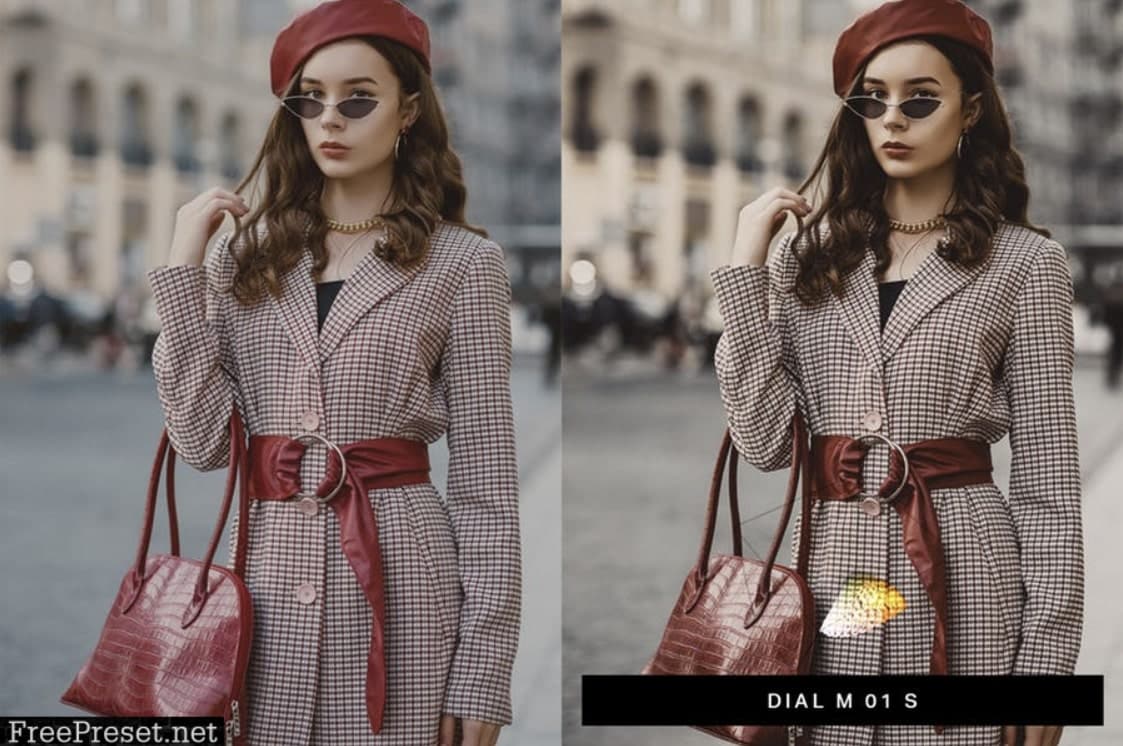
2. Free LUTs Ciné Green
If you want to add a cool and moody feel to your content, try using this LUT. It has a greenish-blue tone that can give your photos and videos a mysterious and cinematic look. Moreover, this LUT is excellent for nighttime cityscape shots or dramatic portrait photography. Furthermore, you can use it to create a dark and edgy vibe for your content.

3.Urban LUTs
Urban LUT is a pack of 10 rich-color LUTs you can use on your photos and videos. This pack has a bright and cheerful feel to it. It enhances the colors in your photos and videos, making them pop and look more vibrant. Additionally, you can use it to create a fun and lively atmosphere for your content. Moreover, you can try this pack for your vacation photos or family videos to give them an energetic feel.

4.90’s Vintage LUT Presets
If you want to add a vintage and retro look to your content, 90’s Vintage LUT Presets are perfect. It has a yellow and orange tone that can give your photos and videos an old-fashioned and nostalgic feel. Moreover, it gives your media a 90s feel with ten different LUTs. This pack can create a vintage feel for your content and give your project a throwback look.
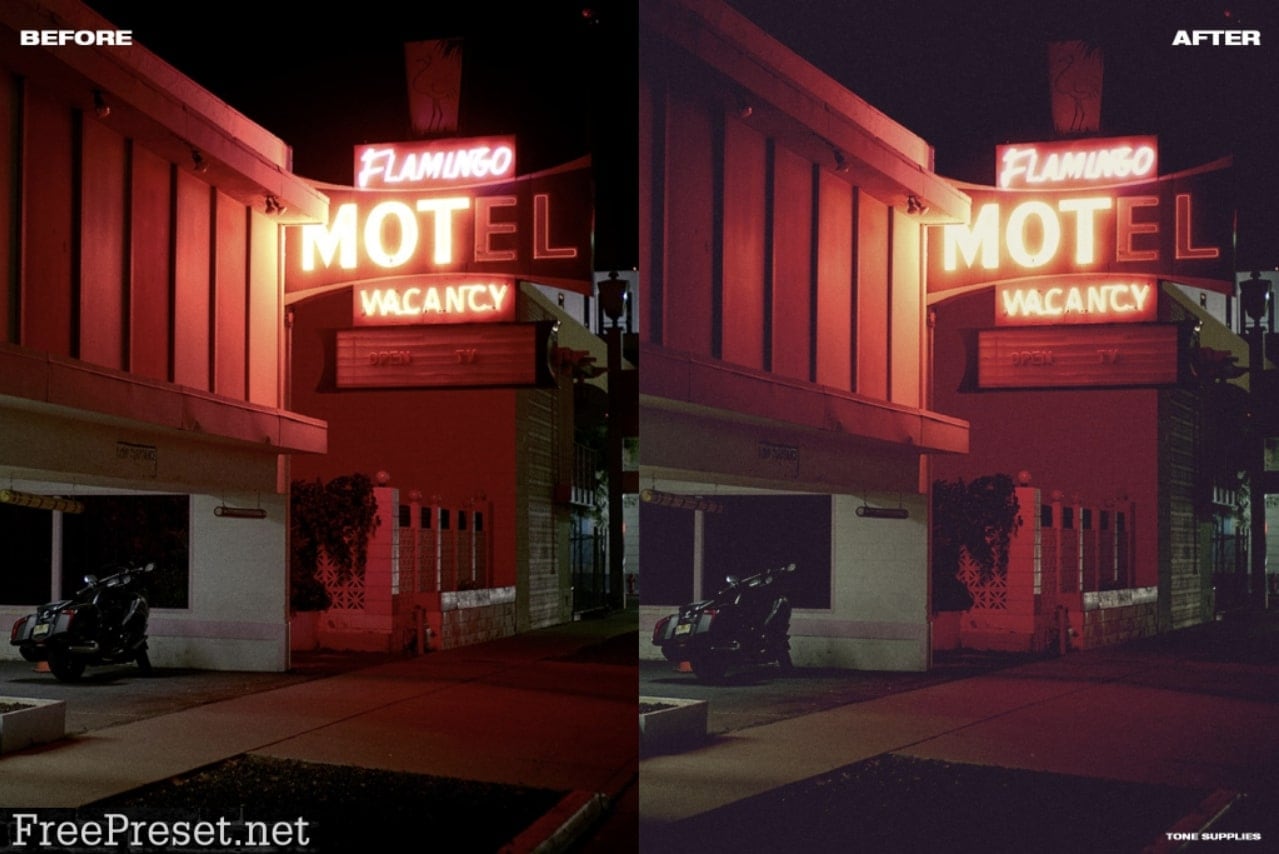
5. 8 Free Pastel Day Lightroom Presets and LUTs
This LUT offers eight paste color-grade presets for photos and videos. This pack has a soft and pastel tone to give your media a dreamy and romantic look for your content. It’s excellent for portrait photography, especially for outdoor shoots with natural lighting. Additionally, you can use it to create a soft and gentle vibe for your content with a more delicate touch.

Bonus Part: Wondershare Filmora: A Great Haven for LUTs
Wondershare Filmora might just be what you need to give your videos a cinematic touch. This powerful tool has over 200+ LUTs in its library to give your videos the perfect tone and color grading. You can even adjust the intensity of the LUTs to match the mood of your videos. Furthermore, you can tweak with basic options like hue, saturation, exposure, white balance, and more.
In addition, Wondershare Filmora offers over 10 billion free stock media for you to use in your photos and videos. Moreover, you can even save your music videos up to 4K resolution with sharper and more detailed results. Additionally, you can use the audio visualizer to match the sound of your video automatically. You can choose from different transitions and effects for your videos as well.
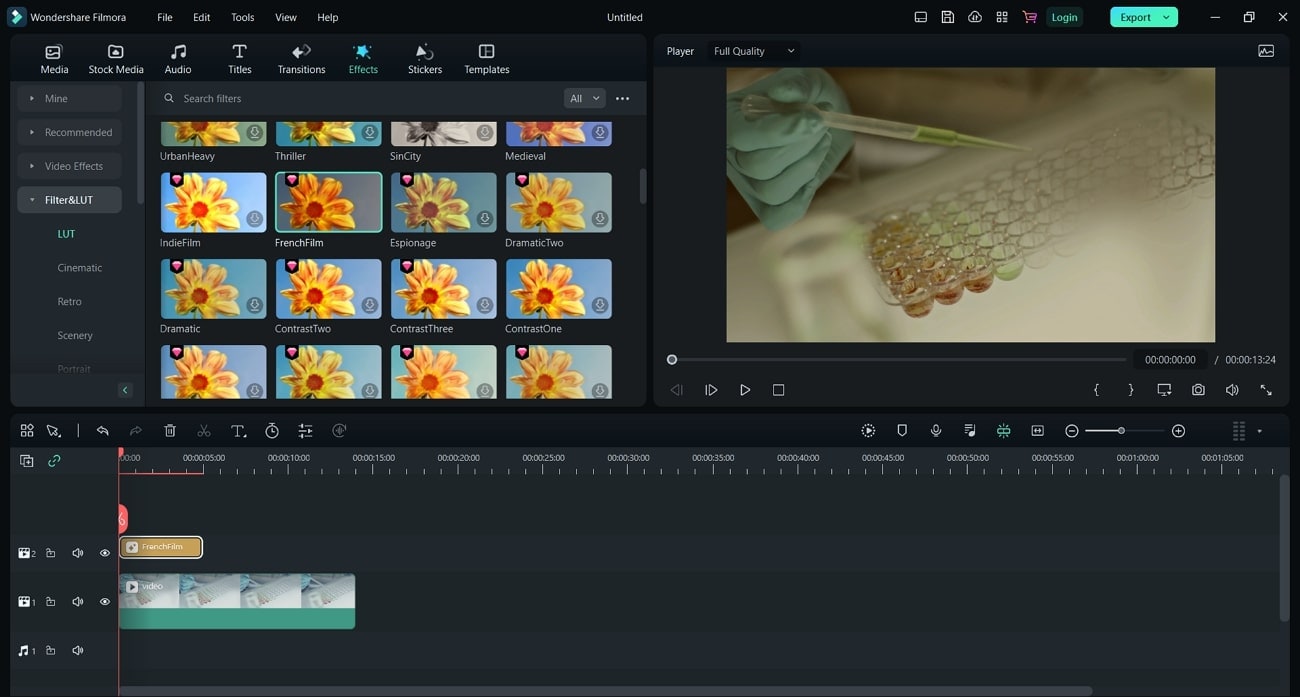
Empower your videos with a new mood using different LUTs. Filmora now offers 100+ top-quality 3D LUTs cover a broad range of scenarios. Transform your videos with Filmora’s powerful 3D LUTs.
Apply LUT on Videos Apply LUT on Videos Learn More

Conclusion
In conclusion, LUTs are a powerful tool for video editors who want to give their videos a cinematic look. You can easily achieve the perfect tone and color grading for your videos and pictures. Moreover, LUTs can save you time and effort in video editing. With many paid and free LUTs for Lightroom available that you can use to create professional-looking videos.
Part 1: How Are LUTs Influencing Video Editors?
There are many ways in which LUTs can help and influence content creators and video editors. From Lightroom presets to Premiere Pro presets, you can download any. However, you need to learn the many ways in which LUTs are helping editors.
Efficiency
LUTs (Lookup Tables) are a powerful tool that can help you in many ways if you are a video editor. First, they can make your editing process more efficient. You can apply color grading and correction to your footage, saving you time and increasing productivity. Instead of manually adjusting the colors for each clip, you can use LUTs to achieve a particular look.
Creativity
In addition to efficiency, LUTs also offer a wide range of creative options. You can use LUTs to explore different styles and moods, from vintage looks to modern cinematic ones. It can help you create a unique style for your videos and make them look more meaningful. With LUTs, you can experiment with different colors and effects to achieve the perfect look for your footage.
Consistency
Another benefit of using LUTs is consistency. With LUTs, you can maintain a consistent look and feel across different video clips. It gives all clips in a project a cohesive and professional appearance. These LUTs can be especially helpful if you work on a long-term project or with multiple editors. It will give a uniform look and feel throughout your project.
Accessibility
LUTs are also becoming more accessible than ever before. With free and paid online options, video editors of all skill levels can access these tools for their video projects. You don’t need extensive training or experience in color grading to use LUTs for your videos. Moreover, anyone can use LUTs with simple steps and make their content look more professional.
Part 2: Top Free LUTs for Lightroom
You don’t need to search for free LUTs for Lightroom for your media content. Here is a list of 5 Lightroom LUTs free to download to color grade your media in different tones.
1.50 Vintage Cinematic Lightroom Presets and LUTs
It is a pack of 50 Cinematic-style vintage LUTs you can apply to your media files. This LUT pack has a warm and orangey tone to give a golden hour and warm color scheme touch. You can use it to create a vintage, nostalgic look for your content. Furthermore, you can use your travel photos or outdoor adventure videos to give them a dreamy rusty vibe.

2. Free LUTs Ciné Green
If you want to add a cool and moody feel to your content, try using this LUT. It has a greenish-blue tone that can give your photos and videos a mysterious and cinematic look. Moreover, this LUT is excellent for nighttime cityscape shots or dramatic portrait photography. Furthermore, you can use it to create a dark and edgy vibe for your content.

3.Urban LUTs
Urban LUT is a pack of 10 rich-color LUTs you can use on your photos and videos. This pack has a bright and cheerful feel to it. It enhances the colors in your photos and videos, making them pop and look more vibrant. Additionally, you can use it to create a fun and lively atmosphere for your content. Moreover, you can try this pack for your vacation photos or family videos to give them an energetic feel.

4.90’s Vintage LUT Presets
If you want to add a vintage and retro look to your content, 90’s Vintage LUT Presets are perfect. It has a yellow and orange tone that can give your photos and videos an old-fashioned and nostalgic feel. Moreover, it gives your media a 90s feel with ten different LUTs. This pack can create a vintage feel for your content and give your project a throwback look.

5. 8 Free Pastel Day Lightroom Presets and LUTs
This LUT offers eight paste color-grade presets for photos and videos. This pack has a soft and pastel tone to give your media a dreamy and romantic look for your content. It’s excellent for portrait photography, especially for outdoor shoots with natural lighting. Additionally, you can use it to create a soft and gentle vibe for your content with a more delicate touch.

Bonus Part: Wondershare Filmora: A Great Haven for LUTs
Wondershare Filmora might just be what you need to give your videos a cinematic touch. This powerful tool has over 200+ LUTs in its library to give your videos the perfect tone and color grading. You can even adjust the intensity of the LUTs to match the mood of your videos. Furthermore, you can tweak with basic options like hue, saturation, exposure, white balance, and more.
In addition, Wondershare Filmora offers over 10 billion free stock media for you to use in your photos and videos. Moreover, you can even save your music videos up to 4K resolution with sharper and more detailed results. Additionally, you can use the audio visualizer to match the sound of your video automatically. You can choose from different transitions and effects for your videos as well.

Empower your videos with a new mood using different LUTs. Filmora now offers 100+ top-quality 3D LUTs cover a broad range of scenarios. Transform your videos with Filmora’s powerful 3D LUTs.
Apply LUT on Videos Apply LUT on Videos Learn More

Conclusion
In conclusion, LUTs are a powerful tool for video editors who want to give their videos a cinematic look. You can easily achieve the perfect tone and color grading for your videos and pictures. Moreover, LUTs can save you time and effort in video editing. With many paid and free LUTs for Lightroom available that you can use to create professional-looking videos.
Also read:
- How to Make a PowerPoint Looping Slideshow
- New In 2024, Best Voice Changers for WhatsApp Free Included
- Wish to Rock on YouTube, but Lacking Tricks? Here, We Will Tell You Everything About How the YouTube Algorithm AI Works and How You Can Perform Well According to AI
- Learn More About the Video Editing Interface of Wondershare Filmora for 2024
- Updated A Comprehensive Guide on VHS Technology and Its Influence on Video Editing for 2024
- Updated Best 5 Tools to Help You Know More Freeze-Frame Video Editing Skills
- Updated How to Create Cooking Video Intro and Outro for YouTube Channel?
- Let Us Talk About the Famous Photoshop and Most Commonly Used Glitch Effect. The Article Understudy Will Discuss in Detail About Photo Glitch Effect
- Updated In 2024, How to Calculate & Change Video Aspect Ratio Online
- Updated Recording Videos with Your Smartphones Is Fun and Fantastic. But Did You Know that Recording in Slo-Mo Has Become a Trend Nowadays? Read More to Learn About How to Convert Videos to Slow Motion Here
- Want to Know the Full Process of Adding the Falling Text Effect as a Video Introduction? Detailed Guidelines on All the Steps Are Mentioned Here for Filmora Users for 2024
- New How to Find a High-Quality Video Marketing Agency?
- Kdenlive Review – Is It The Best Video Editor for 2024
- Use Your Social Media App and Make Slow-Motion Videos by Reading This Guide. Besides Learning Slow-Motion Snapchat, Get Useful Apps Serving the Same Purposes for 2024
- New In 2024, How to Clone Yourself in Videos with Filmora?
- LUTs Can Make Ordinary-Looking Footage Look More Attractive. Read This Guide to Learn How You Can Easily Create Your Own LUTs Using Filmora
- In 2024, How To Brighten Video In Premiere Pro | Step By Step Guide
- New 2024 Approved A Comprehensive Guide on Converting Slo-Mo Videos to Normal Speed Videos On iPhone
- Updated How to Create Datamoshing Effect to Your Footage in After Effects, In 2024
- This Easy Hack Using Wondershare Filmora New Masking Feature Will Be a Great Addition to Your Next Horror Video Content
- 2024 Approved Best Green Screen Software for Beginner on Mac
- New 4 Solutions to Crop a Video on Android Easily for 2024
- In 2024, 10 Apps to Make Videos with Pictures and Music
- Full Guide to Unlock iPhone XS with iTunes | Dr.fone
- Full Guide How To Fix Connection Is Not Private on OnePlus Nord N30 5G | Dr.fone
- 5 Ways to Restart Honor 100 Pro Without Power Button | Dr.fone
- How to Find iSpoofer Pro Activation Key On Infinix Hot 30i? | Dr.fone
- Itel A60s Messages Recovery - Recover Deleted Messages from Itel A60s
- In 2024, How to Unlock SIM Card on Apple iPhone 8 online without jailbreak
- 3 Ways to Change Location on Facebook Marketplace for Xiaomi Redmi Note 12 Pro 5G | Dr.fone
- How to Downgrade Apple iPhone 12 to an Older iOS System Version? | Dr.fone
- 4 solution to get rid of pokemon fail to detect location On Realme GT 5 (240W) | Dr.fone
- How to Unlock Apple iPhone XR Online? Here are 6 Easy Ways
- How to Transfer Photos from Asus ROG Phone 7 Ultimate to New Android? | Dr.fone
- How to share/fake gps on Uber for Vivo Y100 | Dr.fone
- In 2024, Top 10 AirPlay Apps in Vivo X Fold 2 for Streaming | Dr.fone
- In 2024, How does the stardust trade cost In pokemon go On Apple iPhone 12 mini? | Dr.fone
- Title: How to Add a Lower Third to Your Video
- Author: Chloe
- Created at : 2024-05-20 03:37:18
- Updated at : 2024-05-21 03:37:18
- Link: https://ai-editing-video.techidaily.com/how-to-add-a-lower-third-to-your-video/
- License: This work is licensed under CC BY-NC-SA 4.0.



